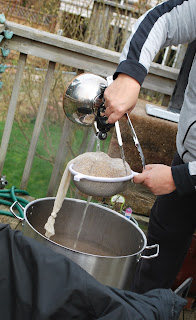It was a windy day out, so I made sure to dress warmly.
(Red always adds so much to an outfit don't you think?)
First step was to sanitize all the equipment, so I prepared an iodine bath,
and soaked everything to be used that day.
Then the fun stuff begins. After bringing 2 gallons of water to a boil the heat is
turned off, and I added grains to seep for a bit. Here's a good shot of
Paul's 34 quart pot, and gas burner (with wind shield).
It's set it on concrete blocks to avoid scorching our wooden deck.
Here I'm straining the grains after seeping.
And then a quick rinse, and we're ready for the next step!
Malt extract is added, and stirred until dissolved.
And stirred some more.
And stirred some more...
And stirred some more! Looks like butterscotch (okay, maybe just to me).
Paul and I took turns stirring for about five minutes to make sure all the sugar
was dissolved. You don't want any sugars settling on the bottom where they'll
burn and discolor the beer. And now the mixture is called Wort!
The Wort is brought back to a boil before the next step. Here I'm checking
temperature to make sure it is at a boil (212F).
Hops are added to the mix. Paul rigged up some old fireplace
screens with heavy plastic sheets for extra wind protection,
and to keep curious dogs from getting burned.
Irish Moss is added after the Hops have boiled for 40 minutes, and
then 15 minutes later a little more Hops. Then it's ready for the cooling process.
This copper coil is really cool. A garden hose is attached to one end.
The water passes through the coil, and goes out another hose (you can see the
stream of water in back of the fence). We added a couple gallons of cold
water to help cool the Wort more quickly. It took a little less than 10 minutes
to cool the Wort to 85F.
Then the beer is strained (to remove the Hops) into the plastic bucket, and water
is added to the 5 gallon mark. The straining is really a two
person job, so we weren't able to get any pictures of that. Some of the
Wort is collected in this tube, and a tube with a weight on one
end is put in. This measure the specific gravity, and this reading
is added to the 5 gallon mark. The straining is really a two
person job, so we weren't able to get any pictures of that. Some of the
Wort is collected in this tube, and a tube with a weight on one
end is put in. This measure the specific gravity, and this reading
helps figure out the alcohol level of the beer.
My reading was 1.053 which is very good.
My reading was 1.053 which is very good.
Liquid yeast is stirred into the Wort, and a lid with an airlock is secured on top. Fermentation should start within 24 hours (you can see bubbling in the airlock), and when that stops it'll be moved to a carboy (the airlock again installed). There are more steps to do 14 days after that which I'll post on a separate blog.












Yay! I can't wait to drink some of it!
ReplyDeleteLove the color of the beer too. I bet it tastes yummy!
ReplyDelete